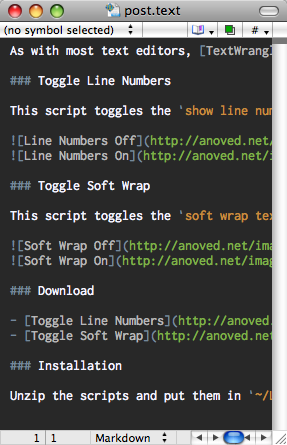

At the bottom of the list click Choose next to All Criteria and look for your EA. Give it a name that fits such as 'Software Updates OK' and click Criteria. In your JSS, click Smart Computer Groups on the left and click the + to create a new group.
Textwrangler applescript examples update#
Now it's time to build a group of computer in the JSS that allow us to update their computers. If you get No Data, then you haven't run the program on that computer yet. When you look at that computer in the JSS, you should see AllowUpdates and either True or False. Now if you go to a computer and Update Inventory (type jamf recon in Terminal). The different if lines turn that 1 or 0 into something more understandable when we look at it in our JSS. The setting line runs the defaults command to get the AllowUpdates value it is currently set to and saves it in a variable called 'setting'. Setting=`defaults read /Library/Preferences/ AllowUpdates` The Inventory Display controls what tab the EA shows up in when looking at a computer record. We are collecting a boolean, but lets set the Data Type to 'String'.

Give the EA a name - perhaps AllowUpdates so it is consistent and a description that makes sense to you. To continue our last project, lets create an EA that shows the status of the AllowUpdates setting we were playing with last time. Extension Attributes are run every time the computer does an inventory (recon). From there, click the + to create a new one. To look for things that are not there, JAMF allows us to write scripts to collect that information.Ĭlick Settings -> Computer Mangagement -> Extension Attributes. The JSS has lots of built in items it looks for when running Inventory, such as Operating System version and RAM.

To do that, we create an Extension Attribute. Now that the data is saved on the computer, we need to see it in our JSS so we can work with it.
Textwrangler applescript examples software#
And once we get this app working, you can add other information that may be relevant in your environment - perhaps what software a computer is licensed for? or the name of the person responsible for the computer? In the last article () we created a simple application which writes a flag to the computer specifying if we could run updates on the computer or not.


 0 kommentar(er)
0 kommentar(er)
